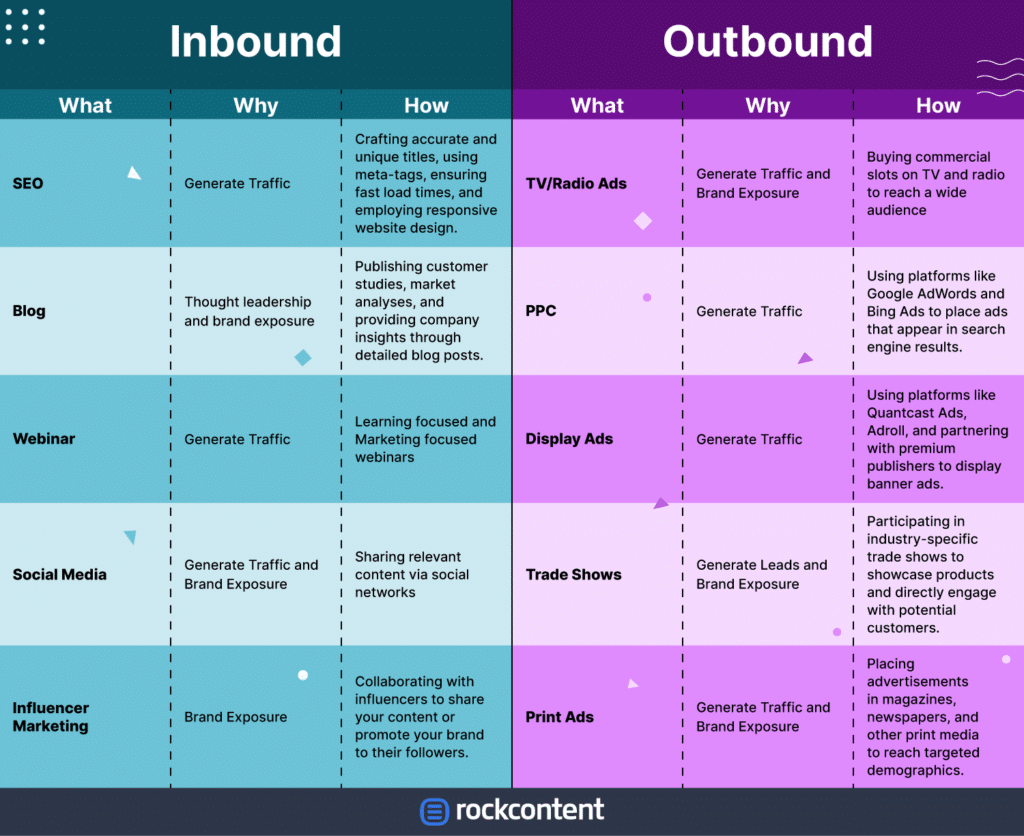Nowadays, customers have access to a lot of information about what they want to buy.
Because of that, it’s essential to create a structured sales process, especially when we talk about complex sales.
If your company is interested in making business agreements and has a long-term purchase cycle, Outbound Marketing strategies may be a good investment.
For that to happen, you need to understand what Digital Marketing is and its processes. These are fundamental actions to improve the results of your company.
This guide shows you everything you need to know about Outbound Marketing, what the benefits are, and how to implement a strategy to get the best results for your company.
Keep reading to understand more about:
- What is Outbound Marketing?
- What are the Pros and Cons of an Outbound Marketing Strategy
- Outbound Marketing vs Inbound Marketing: What are the Differences?
- How to Run a Successful Outbound Marketing Strategy
- 7 Outbound Marketing Tactics That Still Work Today
- Bonus: Should You Move from Outbound Marketing to Inbound?
- Enhancing Outbound Marketing with Advanced Content Solutions
What is Outbound Marketing?
Outbound Marketing is an active prospecting process. This strategy includes actions that enable your sales team to approach your brand’s potential customers directly.
The process considers the customer journey and happens objectively, allowing your company to measure the results.
By using Outbound Marketing strategies, your sales team can reach a larger number of customers.
What are the Pros and Cons of an Outbound Marketing Strategy
There’s a right time to implement an Outbound Marketing operation in a company.
It depends on some aspects of the sales process. To understand if this method fits your business, you can analyze its pros and cons. Check it out below!
Pros
An effective Outbound Marketing strategy is:
- predictable;
- highly-customized;
- a complement to Inbound Marketing actions.
Predictable
When the company structures the sales process, it’s possible to know the conversion rates of each sales team member, the stage of the funnel your customers are in, and other relevant information.
All these data will inform you on how to plan your business growth.
If you need 2 salespeople to convert 100 leads into 10 customers, you can increase your sales by hiring more salespeople.
Highly-customized
The close approach of Outbound Marketing allows a higher level of customization.
This way, you can build a customer relationship based on their needs and goals. This strategy increases the chances of closing deals.
A complement to Inbound Marketing actions
When a company has an Inbound Marketing strategy implemented and running, it can attract more leads.
But this approach may not work correctly if there’s no plan for the next steps.
A strategy that complements this process is Outbound Marketing, influencing these leads to close the deal.
Cons
An Outbound Marketing strategy can generate great results, but you need to consider the cons of those actions. The main ones are:
- high-cost;
- one-way communication;
- adblocking.
High-cost
Outbound Marketing strategies usually involve bigger budgets, and it scares most companies.
The operation needs a qualified team, specific tools, and strong management to work. Besides, the company must know the cost may raise during the campaign.
That’s why it is so important to measure the Return on Investment (ROI).
[ion_script src=”https://ionfiles.scribblecdn.net/scripts/ionizer-1.4.2.min.js” hash=”eyJ1cmwiOiIvL2ludGVyYWN0aXZlLnJvY2tjb250ZW50LmNvbS9lbi9ibG9nL3JvaT9faW9uX3RhcmdldD1lbWJlZC0xLjAiLCJpZCI6Il9pb25faW9uaXplcl8xNjk3NDg2ODExOTMyIiwiZnVsbFNjcmVlbiI6ZmFsc2V9″]
One way communication
Digital Marketing strategies run to grab the customer’s attention in indirect ways. The result is the customers look for the company to buy its solution.
In opposite, Outbound Marketing approaches the clients when they didn’t request.
This action can make them uncomfortable and less oriented towards the purchase.
Adblocking
Another consequence of the unsolicited approach may be an action of blocking by the audience.
Today, many people know how to use technologies such as advertising blockers, phone call blockers, and spam filters for emails.
They’re also very good at unsubscribing from not requested email lists.
Outbound Marketing vs Inbound Marketing: What are the Differences?
Some people compare Outbound Marketing to another marketing process: Inbound Marketing.
So, they treat them as if they were opposites themselves, which isn’t real.
To put it in good terms, they’re more complementary than opposites. To understand how this works, let’s see the differences between them.

Inbound Marketing
Inbound Marketing is a passive method that persuades the lead to come to the company passively.
The company does that by creating attractive content for its audience.
When the leads get in contact with the company, they already know what they want and the product or service that it sells.
Outbound Marketing
Outbound Marketing is an invasive method that presents a company to the public.
Often, the consumers don’t even know they struggle to solve. When a company contacts customers, it helps them discover their problems and offers a solution.
Despite being different strategies, when combined, they allow the company to have better results.
How to Run a Successful Outbound Marketing Strategy
As a structured process, Outbound Marketing has a lot of elements and techniques that we should combine to make things happen. The next topics will explain each one of them. Keep reading to know what you have to do!
1. Recognize lead types and define goals
The first step is to know what are the leads types and define how much of each of them you need to achieve your sales goals.
To do that, we must start by creating a buyer persona profile for each one of these leads.
We’ll define the leads by their acquisition channel:
- Seeds: they come to the company by word-of-mouth method. They don’t need a complex acquisition process, and they’re highly qualified;
- Nets: they’re the leads brought to your company by Inbound Marketing. They’re relatively qualified;
- Spears: they’re the Outbound Sales leads and may or may not be qualified.
2. Get a qualified sales team
Outbound Marketing strategies are common in SaaS — Software as a Service — startups.
These companies generally adopt an internal sales operation, which includes two types of sales professionals.
Companies realize that high-performance salespeople are sometimes unproductive because they need to split up into prospecting and closing processes.
That can be solved by hiring a professional for each stage.
We’ve listed the differences between these two types of salespeople:
- hunters: prospect customers. They make the first contact with the prospect and schedule a meeting;
- closers: show the product, prepare the commercial proposal and the contract, and close the deal.
3. Know the prospect and sales techniques
While starting your strategy, it is important to use some techniques that ensure good results.
Cold mail and cold call
The purpose of a cold call is to prospect the customer that hasn’t made any purchase or contact with your business.
Cold calls can be mistaken for telemarketing, but there are some differences between them.
In cold calls, you need trained and prepared salespeople. In telemarketing, this is not always necessary. The metrics and KPIs can be different too.
One thing you should keep in mind is that some countries have strict policies for commercial calls.
It’s worthy of mentioning that, despite the cons regarding the audience, cold calls can be really effective when well-planned and executed.
AIDA
When using methods such as AIDA, cold calls are more likely to generate good results.
Understand more about AIDA:
- Awareness: you need to get the customers’ attention in the first few seconds of the call or on the email’s subject, showing that your company knows their problems.
- Interests: the second step is to show how your company can solve the consumer problem.
- Desire: your company needs to show the advantages the solution offers to make consumers interested in it.
- Action: finally, you need to make the consumer decide on something, such as booking a meeting or buying your product.

4. Use qualified patterns and frameworks
The lead qualification matrix is a way to understand how fitted the leads are to your business and solutions that you sell.
There’s no sense in a list full of leads that won’t buy your products.
To know how hot is a lead, you have to consider the profile and the maturity axis. Find out what each one represents:
- profile: it’s the main lead’s characteristics, such as annual billing, employee quantity, actuation market and other information that impacts their fit to your product;
- maturity: it’s how much educated the leads are about their problems and if they understand how your product will help them.
Using this matrix, you can discard the leads that won’t buy from you. This way, you’ll better guide and follow up on leads that need more education.
5. Make a lead follow-up and forecast
To ensure the success of your Outbound Marketing strategy, you need to establish a monitoring and forecasting routine.
These practices are very important to keep potential customers on the radar. This way, you can identify and correct problems in the sales process.
Make sure your team is keeping the recommended frequency of tracking customers.
Also, ask professionals to explain their difficulties, achievements, and mistakes. That is important to improve your sales strategy.
6. Analyze the results
It’s essential to monitor the results of the Outbound Marketing actions for many reasons, but mainly to justify the maintenance operation and make adjustments.
To better understand the results, you need to define Key Performance Indicators (KPIs).
The main Outbound Marketing KPIs are listed below:
- Lead Time (LT): how long it takes the lead to advance to the next stage of the funnel. That determines the size of the sales cycle;
- Conversion Rate: the list of how many new leads became customers;
- Customer Acquisition Cost (CAC): is the amount invested in new customers. This indicator determines the value of each customer;
- Lifetime Value (LTV): is the total amount spent by a customer in your company;
- Churn Rate: how many customers cancel the contract before the predicted time.
7 Outbound Marketing Tactics That Still Work Today
Don’t believe anyone who tells you outbound marketing is outmoded and no longer works.
Not only are there many outbound tactics that still work today, but some may even work better on certain members of your target audience depending on who they are, where they live, and other factors.
Here are some great examples.
1. Paid Search Ads
Although search ads actually occupy an interesting grey area between inbound and outbound marketing, as they’ll only be presented to people who have made a related search query, they cast a wide enough net to count as outbound marketing.
They also remain very effective ways to reach highly convertible consumers at opportune times.
Standard SEO strategies mean playing the long game and building authority a little at a time over many weeks or months. But search ads deliver relatively quick results and a near-immediate SERP presence.
Be sure both your ads and your landing pages are on point to maximize results.
2. Social Media Ads
Saying that the average person spends a lot of time on social media nowadays is a real understatement.
The typical median usage these days is about 2.5 hours daily, so social media ads offer marketers an effective way to connect with consumers in their downtime.
Yes, standard social media marketing is fantastic for cultivating lasting connections with customers and building your brand identity. But paid social media ads that cast a wider net make a great option, too.
It’s also a lot more effective and yields results quicker than relying solely on organic reach to get through to your audience.
3. Trade Shows and Live Events
Many digital-age marketers make the mistake of thinking traditional outbound marketing approaches like trade shows, conventions, and other live events are no longer relevant.
However, there’s still a lot of value in getting out and connecting with members of your target audience in person.
Attending such events can come attached to a relatively high upfront cost compared to other methods, but the exposure and the number of leads you can walk away with are priceless.
As with any other type of outbound marketing, make sure you’re maximizing your results by budgeting wisely and setting clear goals.
4. Old-School Advertising (Print, Radio, and TV Ads)
Traditional old-school advertising methods have had to evolve a lot since the internet came along and changed the world of marketing.
However, they’re still relevant ways to potentially reach people. This is especially the case if you’re looking to target older customers.
For example, younger generations may spend hours on social media every day, but consumers 50 and older are much more likely to be watching television.
For instance, Americans between 50-64 years old watch nearly five hours of television daily. Those 65 and over watch closer to 6.5 hours.
5. Cold Email
If it feels like email has been around for ages, it’s because it has.
But it shows no signs of falling out of fashion anytime soon. It also still represents an incredible marketing opportunity for digital-age businesses, especially in a day and age that’s seeing options like newsletters making a real comeback.
The key to success when it comes to outbound marketing tactics like cold emails is to make yours personalized, respectful, and potentially valuable.
Friendly subject lines, personal-sounding messages, and consistently offering the recipient something worthwhile in exchange for their time can help you succeed here.
(Speaking of newsletters, are you subscribed to ours?)
6. Cold Calls
Many forms of outbound marketing have a reputation for being pushy, intrusive, and irritating among other things, and cold calling can definitely be one of them.
But it also remains an incredibly solid way for many businesses — especially those in the B2B sector — to make contact with potential customers.
The key to doing cold calls properly is to adopt the right approach. Do your homework on the potential recipients of your calls to ensure you’re reaching out to the right people.
And focus on establishing and nurturing new relationships instead of attempting to pressure people into making a purchase.
7. Direct Mailing
Snail mail may not be most people’s go-to method of getting in touch with people anymore, but that’s precisely why it’s still an effective way to generate potential leads.
In a day and age that’s all about email or social media, it feels different (and really pretty cool) to see something addressed to you in your actual mailbox.
As with many forms of outbound marketing, your rates of success with direct mailing will depend a lot on your approach.
As always, make sure you’re choosing the right target audience based on factors like demographics, location, and purchase history.
Help your mailers stand out by being creative, witty, and innovative with your campaigns, as well.
Bonus: Should You Move from Outbound Marketing to Inbound?
Although there are still plenty of advantages to outbound marketing, most digital-age businesses do want to make at least a partial transition to inbound marketing at some point.
Here are some tips for doing it right and maximizing your chances of success.
Identify your goals
As with any marketing strategy, it’s crucial to have clear goals in mind when it comes to inbound marketing. Consider why you want to make the move, as well as why you want to make it now.
Are you looking to drive more traffic to your site, reach a different market, or do something else entirely?
If you don’t know where you’re trying to go (and by when), you won’t ever know whether you’ve succeeded.
Know your target audience
Knowing who you’re trying to reach with your marketing strategies is always essential, but accurate targeting is crucial with inbound marketing.
Make sure you know exactly which members of your larger audience you’re trying to reach with each campaign and piece of content.
Modern consumers and younger markets prefer personalized, low-key marketing that feels tailor-made just for them.
Who your audience is and what their needs are should determine details like language choice, the types of content you create, and so forth.
Support your inbound marketing content with outbound marketing
Successful inbound marketing campaigns hinge on the consistent production of great content and plenty of it.
Think articles, videos, and blog posts that are helpful, informative, or entertaining — marketing material that doesn’t feel like marketing material at all.
You can also use your best outbound marketing tactics to help your inbound marketing campaigns gain better traction.
For example, you can use your pay-per-click advertising campaigns to link to high-value blog posts instead of your homepage. Send out an email blast to your subscriber list to promote options like video tutorials, ebooks, etc. Be creative.
Enhancing Outbound Marketing with Advanced Content Solutions
While outbound marketing focuses on reaching out to potential customers, the effectiveness of these efforts is greatly enhanced by high-quality content. WriterAccess provides an ideal solution for producing such content by offering access to a diverse pool of over 15,000 vetted professionals, including writers, designers, and strategists.
These experts specialize in creating compelling content that can make outbound campaigns more persuasive and impactful.
WriterAccess and Outbound Marketing Synergy
Integrating WriterAccess into your outbound marketing strategy can dramatically increase your campaign’s reach and effectiveness. The platform’s advanced tools, such as AI-driven analytics and an extensive image bank, enable marketers to create tailored content that resonates with specific audiences. This precision helps in crafting messages that are not only relevant but also highly engaging.
Moreover, WriterAccess offers the unique WriterAccess Humanizer service, which enhances AI-generated content with human creativity. This ensures that your content maintains the personal touch necessary for effective outbound marketing. Whether you’re sending direct emails, creating brochures, or launching targeted ad campaigns, the content crafted by WriterAccess professionals can help you connect with your audience on a deeper level.
Start Amplifying Your Outbound Efforts Today
Ready to revolutionize your outbound marketing strategies?
Sign up for a free 14-day trial at WriterAccess and explore how our expert content creation can amplify your outreach efforts.
With WriterAccess, ensure your messages are not just seen but felt. Begin your journey to more powerful marketing today!









